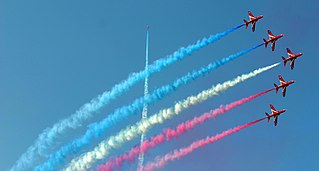
A dye is a colored substance that chemically bonds to the substrate to which it is being applied. This distinguishes dyes from pigments which do not chemically bind to the material they color. Dye is generally applied in an aqueous solution, and may require a mordant to improve the fastness of the dye on the fiber.

Paint is any pigmented liquid, liquefiable, or solid mastic composition that, after application to a substrate in a thin layer, converts to a solid film. It is most commonly used to protect, color, or provide texture to objects. Paint can be made or purchased in many colors—and in many different types, such as watercolor or synthetic. Paint is typically stored, sold, and applied as a liquid, but most types dry into a solid. Most paints are either oil-based or water-based and each has distinct characteristics. For one, it is illegal in most municipalities to discard oil-based paint down household drains or sewers. Clean-up solvents are also different for water-based paint than they are for oil-based paint. Water-based paints and oil-based paints will cure differently based on the outside ambient temperature of the object being painted Usually, the object being painted must be over 10 °C (50 °F), although some manufacturers of external paints/primers claim they can be applied when temperatures are as low as 2 °C (35 °F).

Anthracene is a solid polycyclic aromatic hydrocarbon (PAH) of formula C14H10, consisting of three fused benzene rings. It is a component of coal tar. Anthracene is used in the production of the red dye alizarin and other dyes. Anthracene is colorless but exhibits a blue (400–500 nm peak) fluorescence under ultraviolet radiation.

A smoke bomb is a firework designed to produce smoke upon ignition. Smoke bombs are useful to airsoft games, paintball games, self-defence and practical jokes. They are also used in smoke tests.

A smoke screen is smoke released to mask the movement or location of military units such as infantry, tanks, aircraft, or ships.

Powder coating is a type of coating that is applied as a free-flowing, dry powder. Unlike conventional liquid paint which is delivered via an evaporating solvent, powder coating is typically applied electrostatically and then cured under heat or with ultraviolet light. The powder may be a thermoplastic or a thermoset polymer. It is usually used to create a hard finish that is tougher than conventional paint. Powder coating is mainly used for coating of metals, such as household appliances, aluminium extrusions, drum hardware, automobiles, and bicycle frames. Advancements in powder coating technology like UV curable powder coatings allow for other materials such as plastics, composites, carbon fiber, and MDF to be powder coated due to the minimum heat and oven dwell time required to process these components.
Vat dyes are a class of dyes that are classified as such because of the method by which they are applied. Vat dyeing is a process that refers to dyeing that takes place in a bucket or vat. The original vat dye is indigo, once obtained only from plants but now often produced synthetically.

Colored smoke is a kind of smoke created by an aerosol of small particles of a suitable pigment or dye.

Quinizarine Green SS, also called Solvent Green 3 is an anthraquinone derivative. It is a black powder that is soluble in polar organic solvents, but insoluble in water. It is used as a dye for adding greenish coloring to cosmetics and medications. It is used in some colored smoke formulations.

Disperse Red 11, or 1,4-diamino-2-methoxyanthraquinone, is a red disperse dye derived from anthraquinone.

Oil Blue 35 is a blue anthraquinone dye used for colouring alcoholic and hydrocarbon based solvents, including oils, fats, and waxes. It is used also in lacquers and inks. In some countries, it is used as a fuel dye. It is also used in some blue colored smoke formulations. In microscopy, it is used as a staining dye. When exposed to 5% hydrochloric acid solution, it becomes dirty green.

Benzanthrone (BZA) is a polycyclic aromatic hydrocarbon. It is a yellow solid. Its derivatives are used as a dyestuff intermediate for anthraquinone-based dyes. Dehydrogenative coupling gives violanthrone. It is prepared by reduction of anthroquinone to anthrone followed by alkylation with a mixture of glycerol and sulfuric acid.

Solvent Violet 13, also known as D&C Violet No.2, oil violet, Solvent Blue 90, Alizarine Violet 3B, Alizurol Purple, Duranol Brilliant Violet TG, Ahcoquinone Blue IR base, Quinizarin Blue, Disperse Blue 72, and C.I. 60725, is a synthetic anthraquinone dye with bright bluish violet hue. It is a solid insoluble in water and soluble in acetone, toluene, and benzene. Its chemical formula is C21H15NO3, and its structure is 1-hydroxy-4-(p-tolylamino)anthraquinone, or 1-hydroxy-4-[(4-methylphenyl)amino]-9,10-anthracenedione or 1-hydroxy-4-(4-methylanilino)anthraquinone.

For the parent molecule 9,10-anthraquinone, see anthraquinone

Anthraquinone dyes are an abundant group of dyes comprising a anthraquinone unit as the shared structural element. Anthraquinone itself is colourless, but red to blue dyes are obtained by introducing electron donor groups such as hydroxy or amino groups in the 1-, 4-, 5- or 8-position. Anthraquinone dyestuffs are structurally related to indigo dyestuffs and are classified together with these in the group of carbonyl dyes.

1,4-Diamino-2,3-dihydroanthraquinone is an anthraquinone dye used with Disperse Red 9 in colored smoke to introduce a violet color. It is also used in dyes and marine flares.

Paper chemicals designate a group of chemicals that are used for paper manufacturing, or modify the properties of paper. These chemicals can be used to alter the paper in many ways, including changing its color and brightness, or by increasing its strength and resistance to water.
Disperse dye is a category of synthetic dye intended for polyester and related hydrophobic fibers. Disperse dyes are polar molecules containing anthraquinone or azo groups. It is estimated that 85% of disperse dyes are azos or anthraquinone dyes.
Waterborne resins are sometimes called water-based resins. They are resins or polymeric resins that use water as the carrying medium as opposed to solvent or solvent-less. Resins are used in the production of coatings, adhesives, sealants, elastomers and composite materials. When the phrase waterborne resin is used it usually describes all resins which have water as the main carrying solvent. The resin could be water soluble, water reducible or water dispersed.

Disperse Red 60, or 1-amino-4-hydroxy-2-phenoxyanthraquinone, is a popular disperse dye of the anthraquinone family of dyes. It is a dark red solid that is insoluble in water but soluble in dichloromethane.


















